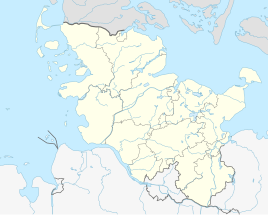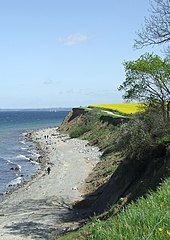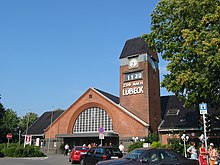Lübeck-Travemünde
|
Travemünde
City of Lübeck
Coordinates: 53 ° 57 ′ 38 ″ N , 10 ° 52 ′ 9 ″ E
|
||
|---|---|---|
| Height : | 3 m | |
| Residents : | 13,534 (March 31, 2016) | |
| Incorporation : | 1913 | |
| Postal code : | 23570 | |
| Area code : | 04502 | |
|
Location of Travemünde in Schleswig-Holstein |
||
Lübeck-Travemünde ( Low German Travemünn ) is a district of the Hanseatic city of Lübeck in Schleswig-Holstein , which is located directly at the mouth of the Trave in the Bay of Lübeck as part of the Baltic Sea . The district in the political sense includes the district of Alt-Travemünde , which is often equated with Travemünde in parlance, as well as the districts of Priwall , Brodten , Teutendorf and Ivendorf . The latter three are small villages that were incorporated in 1935.
geography
Lübeck-Travemünde is about 14 kilometers as the crow flies northeast of the center of Lübeck. Most of the district is west of the Trave. The Priwall peninsula on the east bank at the mouth of the Baltic Sea also belongs to Travemünde.
The area of the district is 41.3 square kilometers. At the end of March 2016, 13,534 people lived in Travemünde, i.e. 328 people per square kilometer. Most of the residents live in the district of Alt-Travemünde . In the three other villages of Brodten, Teutendorf and Ivendorf, which belong to the district, only between 100 and 300 inhabitants each live.
history
Travemünde was founded in 1187. With the Lübeck Imperial Freedom Letter of 1226, the city of Lübeck had the decisive rights to Travemünde guaranteed by Emperor Friedrich II . At that time the Priwall came to Travemünde. In 1329 Travemünde finally became part of the then Lübeck city-state. Travemünde has been strongly fortified since the time of Henry the Lion . During the Danish-Luebian War , a Danish attack was repelled in 1510.
In 1802, Travemünde became the second place on the German Baltic coast to be " Seebad ".
The fortifications of Travemünde were razed in 1807 .
From 1811 to 1813 Travemünde was, like Lübeck, part of the French Empire and thus its northeasternmost place. At that time was to enforce the Continental Blockade the Fort Travemünde built.
In 1872 Travemünde was severely damaged by the storm floods in the Baltic Sea , and numerous houses fell victim to the floods. Traces of the storm surge can still be seen here and there.
In 1913 the city of Travemünde was incorporated into Lübeck.
politics
Travemünde has an informal local council that acts as a mouthpiece for the administration and politics of the Hanseatic city of Lübeck, but has no decision-making powers of its own. 15 of the 20 representatives are chosen by the political parties for the citizenship election according to the respective Travemünder election result. In addition, another five representatives of public life are assigned to the local council.
Promenades and bathing
The travepromenade
The Travepromenade leads along the Trave to its mouth in the Baltic Sea. Here are sailing boats, pilot boats and lifeboats of the German Society for the Rescue of Shipwrecked People . The Priwall VI passenger ferry to Dünenweg departs here.
Promenade
The beach promenade along the Baltic Sea with a wide sandy beach was built between 1898 and 1899 and was inaugurated in 1904. The special atmosphere results from the generous dimensions and the view of the swimming pool and the international ferry traffic. From the end of 2010 to mid-2012, sections of the beach promenade were provided with a storm-proof substructure made of asphalt and granite paving. What has remained are the wrought iron railings between the promenade and the beach. Newly added were barrier-free beach access, play areas for children, a lake terrace and a beach bar. At the northern end of the beach promenade goes up the hill into the largely natural landscape of the Brodten steep bank with the Hermannshöhe viewpoint or into a footpath to the Mövenstein near the beach .
Bathing beach on the promenade
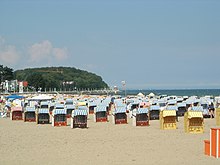
Travemünde has two beaches facing the Baltic Sea : the beach on the beach promenade and the beach on the Baltic Sea shore of the Priwall . The main bathing season is from July to August with water temperatures around 20 ° Celsius.
The fine sandy beach of the promenade is 1.7 kilometers long, 1700 beach chairs are available. It has observation towers of the German Life Saving Society (DLRG) . The water rescue service at the DLRG water rescue station is only on duty when a striated red and yellow pennant is hoisted on top of the flagpole. If a yellow flag is also hoisted underneath, bathing and swimming is dangerous. If instead a red flag is also hoisted underneath, bathing and swimming is prohibited.
Strong north-easterly winds can cause life-threatening undercurrents that pull swimmers out into the sea. An indication of this is when the sea water from the beach to the horizon shows waves with whitecaps.
Cultural, natural monuments and buildings
Old lighthouse
In 1539 the old lighthouse Travemünde was built from bricks by Dutch masons. It is around 31 meters high and consists of eight floors, each of which decreases in diameter. It is the oldest surviving lighthouse in Germany and has been a technical cultural monument since 1922. In 1827 it was struck by lightning and the tip burned off completely. In 1903 the beacon was switched to electric light. Germany's longest-serving lighthouse ceased operations in 1972 because the view was obscured by the new construction of the Maritim high-rise .
The old lighthouse Travemünde has served as a maritime museum for beacon technology since 2004. On the walls of the stairs and on the eight floors there are pictures of lighthouses and lightships as well as sea lanterns and beacons. The pilot's lookout for the Baltic Sea can be viewed halfway up. On the top floor there is a narrow balustrade around the tower. From there, a panoramic view of the Baltic Sea, Travemünde, Priwall, Passat and the ship and ferry traffic is possible.
Maritime high-rise / New beacon
The Maritim high-rise was built in the early 1970s. At 119 meters (125 meters total) it is the tallest building in Schleswig-Holstein and on the entire German Baltic coast. The new beacon on the 36th floor of the skyscraper was put into operation on April 30, 1974 and, with a fire height of 114.7 m, is one of the highest beacons in Europe. The white / red light signal flashes every four seconds in a sector pointing north-east towards Lübeck Bay. The building was added to the list of cultural monuments of the Hanseatic City of Lübeck in July 2019 .
Nordermole
The Nordermole extends to the point where the Trave flows into the Baltic Sea. At the far end is the Travemünde Pier , a green and white lighthouse.
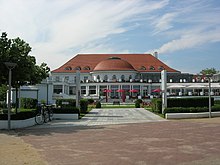
Former casino
The building of the former casino was built in the Art Nouveau style in 1913/1914 as the “Städtischer Kursaal” or “Konversationshaus”. The outdoor facilities were designed in 1915 by the well-known Lübeck garden architect Harry Maasz . The Casino Travemünde was in operation from 1949 to 2012. There is now a hotel in the house. From 2005 to 2015 there was the restaurant "La belle Epoque", which was awarded three Michelin stars in 2012 under Kevin Fehling .
Former Kurhaus Hotel
The Kurhaus-Hotel am Kalvarienberg, which defines the townscape, was renovated and rebuilt and then reopened as the A-ROSA Resort . Inside, there are still features of the previous single-storey building, which were created in 1820 in the classicism style by interior designer Joseph Christian Lillie . The kitchen of the restaurant belonging to the hotel has been awarded two Michelin stars under the direction of Christian Scharrer since 2011 . In 2014 there was a change in kitchen management. Dirk Seiger, who was the sous-chef of the Buddenbrooks restaurant until 2011, took over the management of the fine dining restaurant. In 2017 the restaurant was awarded a Michelin star and 16 points and two toques in the Gault Millau guide for its cuisine.
Beach station
The Lübeck-Travemünde Strand station on the railway line was built in Art Nouveau style in 1911–1913 as a replacement for a wooden predecessor from 1900 based on plans by the architect Fritz Klingholz . In 2000 it was extensively restored for almost 2.3 million euros. As a special feature, it has a clock tower with a display of the next train departure that can be seen all the way to the beach.
Port station
The current building was also built in 1913/1914 according to plans by Fritz Klingholz. The predecessor had already been completed with the opening of the Lübeck-Travemünder railway line in 1882. At the request of the railway company, the city built a connecting road between the port station and the jetties on the front row, which was named Rose . In 1996 the station building was sold and used as a restaurant. Today, after extensive interior work, there is a theater in the former station building.
Mövenstein
The Mövenstein is a boulder registered as a natural monument since 1980 , which was once used by the bathers of the former seaside resort Mövenstein. It threatens to sink into the Baltic Sea and only two-fifths stick out of the water.
graveyard
The cemetery is located north of the railway line with the main entrance on the Mühlenberg street. At the side entrance to Boelckestrasse there are seven similarly prepared graves with the names of the deceased and the common date of death in 1945. There is no explanatory panel about these war graves .
memorial
In the Dr.-Heinrich-Zippel-Park there is the war memorial to the memory of the dead of the First and Second World War at the entrance to the Kalvarienberg. A memorial service is held here on Memorial Day by the pastor and reservist community with the participation of the Travemuender and visitors.
Old town


In the old town of Travemünde around the St. Lorenz Church built in the second half of the 16th century with an organ by Rudolf von Beckerath Organ Builders . The old Lübschen Vogtei in the style of the brick renaissance was the seat of the Lübeck lords as well as the police station and is used commercially today. The original character has been preserved in the front row on both sides of the Ostpreußenkai .
Four-masted bark Passat
The four-masted barque Passat is a museum ship and landmark at the mouth of the Trave at the Priwall Passathafen with its numerous sailing yachts (only during the sailing season) . The Passat was built in 1911 as a grain and saltpeter transporter and placed under monument protection in 1959 by the Hanseatic City of Lübeck. She sailed around Cape Horn thirty-nine times and circled the world twice. It can be visited, has three function rooms, 98 bunks and a registry office . The masts are 56 meters high. In the run-up to Christmas and Christmas, it is decorated with a chain of lights over the top.
The Passat was once one of the legendary Flying P liners operated by the Hamburg shipping company Laeisz . She is the sister ship of the Beijing, which is currently being restored in the Peters shipyard in Wewelsfleth , and is related to the Pamir, which sank in the Atlantic . The P-Liners also include the Kruzenshtern , which was formerly called Padua , and regularly visits Travemünde as an active Russian sailing training ship as part of the Baltic-Sail.
urban planning
The streetscape between Kaiserallee and Steenkamp is arranged in such a way that the streets port , starboard , midships and aft deck draw the image of a ship on the city map. This “ship” in the city map even has a stairway with which it is docked on Kaiserallee . This ship theme also includes the streets Im Dinghy , Am Stern , Godewind (good wind) and Leegerwall (from Lee , lee side ).
Nature and parks
(from west to east)
The Priwall hiking trail leads around the nature reserve of the southern Priwall.
The Kalvarienberg (popularly: Kalli-Walli) is a densely wooded elevation that is bordered by the old town of Travemünde, the beach station as well as the outer avenue and the railway line. The almost five hectare large area of this urban forest is crossed by two paths in a south-north direction and managed in a natural way.
The Dr. Heinrich-Zippel-Park extends below the Kalvarienberg and is crossed by an avenue for pedestrians from the back row towards the Baltic Sea promenade. In the Zippelpark, on the ascent to the Kalvarienberg, there is a memorial to those who fell in the world wars. In 2018, a nostalgic Persil clock was installed in the Zippelpark instead of a destroyed advertising clock that was listed as a historical monument .
The Brügmanngarten is grouped around a music shell on the Baltic Sea promenade. Spa concerts and events with loud music take place here. The Godewindpark at Travemünder Strandbahnhof is a quiet zone with oaks, maples, a pond and a large lawn.
Travemünde also includes the Brodtener Ufer , an impressive steep coast up to 20 meters high and about four kilometers long to the neighboring town of Niendorf , with a golf course behind it, which is one of the oldest in Germany.
In the immediate hinterland of Travemuende, but already in the Ostholstein district , lies the Hemmelsdorfer See . This lake is a fjord cut off from the Baltic Sea , in which Napoleon once wanted to build a protected naval port for his empire.
- additional
Former Possehl villa, today Restaurant Villa Mare
Pomerania Center with Reconciliation Church
Museums and memorials
The Seebadmuseum Travemünde documents the development of Travemünde as a seaside resort, the history of the use of the Priwall as a site for the development of seaplanes (including the Dornier ) and as a shipyard location. Furthermore, the reception of the refugee flows of the Second World War and the situation on the former border with the GDR are presented.
A historic propeller is set up in front of the Maritim Hotel in the direction of the beach promenade, which is intended to remind of the history of the Priwall as a sea flight test site.
Next to the clubhouse of the Eisenbahner-Hochsee-Sportfischer-Verein (EHSFV), a former water tower of the Lübeck-Büchener Eisenbahn (LBE) northeast of the port station, there is section “a” of the former Reichsbahn motorcar 137 851 of the “Cologne” type (later VT 06 106 of the DB ).
In the annual market street 4 near the Lorenzkirche a memorial plaque commemorates the escape of Willy Brandt in April 1933 from Travemünde to Denmark. Paul Stooß enabled Brandt to escape in a motor cutter.
Public transportation
railroad
The district is served from Hamburg and Lübeck via the Lübeck – Lübeck-Travemünde Strand railway line, which has been electrified since 2008, with regional trains (2016: DB Regio ) every hour. The Travemünde Hafen – Niendorf branch was shut down on September 29, 1974 and, after the track system had been dismantled, large sections of it were converted into a cycle and hiking trail.
The three Travemünde railway stations are from south to north Lübeck-Travemünde Skandinavienkai, Lübeck-Travemünde Hafen (near the old town) and Lübeck-Travemünde Strand (near the beach promenade and the Kurhaus). The Lübeck-Travemünde Skandinavienkai train station is now far from the check-in of the Baltic Sea ferries. At the Skandinavienkai there is a lot of freight traffic, with the freight trains running on their own route towards Lübeck.
International ferry traffic
Travemünde with its Skandinavienkai is one of the most important German ferry ports for traffic with Finland, Sweden ( Malmö and Trelleborg ) and the Baltic States. The Skandinavienkai is directly connected to the federal highway 75 by a junction . The through traffic is thus kept away from Travemünde.
City ferries
A combined passenger and car ferry operates between the Priwall peninsula on the right of the Trave on the border with Mecklenburg-Western Pomerania and the center of Travemünde. There is also a passenger ferry from the Nordermole at the old lighthouse in Travemünde to the Priwall in the summer months.
Bus transport
There are bus connections to Lübeck with express bus line 40 or lines 30 and 31 of the Lübeck-Travemünder Verkehrsgesellschaft (LVG). There are local buses 35 and 38 within Travemünde (every 2 hours on weekdays) . The seaside resorts of the Lübeck Bay from Travemünde via Niendorf , Timmendorf to Scharbeutz are connected by line 40 of the LVG. After Bad Schwartau , on line 33rd
Air traffic
The nearest airport is Lübeck Airport in Lübeck-Blankensee, which is connected to the ZOB at the main train station in Hamburg via the motorway via the VHH bus line A24 and runs in Lübeck at the same time as the flight times. Hamburg-Fuhlsbüttel is the more important international airport in Hamburg .
Streets
Travemünde can be reached via the A 1 / A 226 and the motorway-like federal highway 75 . Travemünde is connected to the north-west baths of the Bay of Lübeck and Holstein Switzerland by the B 76 bathing road .
Tourist transport links
Around 20 cruise ships call at Ostpreußenkai every year and bring visitors to Travemünde. A few cruise ships dock at Skandinavienkai. Most cruise ships dock between June and August.
From April to the beginning of October, small passenger ships sail the route between the Travemünder Vorderreihe and the Lübeck swing bridge in 90 minutes twice a day. You open up the natural and industrial landscape of the Trave.
The Hanseatenweg hiking trail, initiated by Germany's Friends of Nature, runs through Lübeck, Travemünde and the Priwall. It already exists between the Hanseatic cities of Osnabrück, Bremen, Hamburg, Lübeck, Wismar and Rostock. It is planned for the entire route from Bruges in Belgium to Narva in Estonia.
Some long-distance cycle routes run through Travemünde, including the Iron Curtain Trail , which runs from Norway to the Black Sea along the former Iron Curtain , and the Baltic Sea Cycle Route , which encircles the Baltic Sea with a length of over 7,000 km.
Events
- May 1st, 11 a.m .: A maypole with handicraft symbols is set up in front of the St. Lorenz Church in Travemünde on the old market square.
- May to October: WindArt Travemünde: Kinetic art on the green areas of Travemünde, e.g. B. in front of the Old Bailiwick
- Every year in summer, the Travemuender Week takes place from Leuchtenfeld under the leadership of the Lübeck Yacht Club (LYC) with around 2500 active people and over 1000 boats, similar to the Kiel Week . The Travemünder Woche is a sailing regatta on ten regatta courses with keel yachts, catamarans and gliding dinghies.
- In December on the Advent weekends: The Christmas market for handicrafts takes place in the cruise terminal on Ostpreußenkai.
- December 24th from 2 p.m .: Christmas Eve at the lighthouse
There are also regular smaller events.
Between 2002 and 2007, the Sand World sand sculpture festival took place in Travemünde every year .
education
- City School Travemünde (elementary school, until 2009 elementary and secondary school), shepherd's walk, 204 students in 9 classes
- School by the sea (elementary and community school), Steenkamp / Ecke Strandweg, 330 students in 16 classes
- Vocational training center of the Lübeck Chamber of Crafts , Wiekstraße 5 (Priwall)
- Schleswig-Holstein Seaman's School, Wiekstrasse 3a (Priwall)
Student numbers from the school year 2019/2020
Churches
- Evangelical-Lutheran: St. Lorenz , Kirchenstraße / Reconciliation Church in the Pomeranian Center (consecrated 1991)
- Roman Catholic: St. George, Rose
- other religious communities: New Apostolic Church, Moorredder
Personalities

In the Buddenbrooks , the Lübeck Nobel Prize winner Thomas Mann recorded the bathing holiday and seaside activities of the 19th century in literary terms. Painters like Edvard Munch , Gotthardt Kuehl , Ulrich Hübner and Erich Dummer depicted summer life in the seaside resort and marina. Their paintings are exhibited in the Lübeck art museum Behnhaus and bear witness to Travemünde's past.
In 2002, the Timmermann fountain was dedicated to the dialect poet and narrator Otto Timmermann (1916–2008), sexton of the St. Lorenz Church and Travemuender original .
Peter Deilmann , the founder of by the ZDF television series The Love Boat known eponymous Peter Deilmann Reederei in Neustadt in Holstein , VIVA presenter Gülcan Kamps (born Karahanci) Rötger Feldmann aka "crumbs", German cartoonist Peter Nogly , German national football team and the soccer coach Bernd Schröder were born in Travemünde. Antje Buschschulte , swimming world champion, grew up in Travemünde and Eckhard Dagge , second German boxing world champion after Max Schmeling , started boxing in Travemünde. The royal Prussian consul a. D. in Maracaibo and social reformer Emil Minlos died in his villa in 1901.
literature
- Thorsten Albrecht: Travemünde (Small booklets on city history, edited by the archive of the Hanseatic City of Lübeck, No. 19), Lübeck 2005, ISBN 3-7950-3118-4 .
- Rolf Fechner: The old Travemünde-a walk in pictures. Sutton-Verlag, ISBN 978-3-95400-026-5 .
- Rolf Fechner: Living and working in old Travemünde. Sutton-Verlag, ISBN 978-3-95400-614-4 .
- Rolf Fechner: Travemünde in historical aerial photographs. Sutton-Verlag, ISBN 978-3-95400-779-0 .
- Rolf Fechner: Travemünde then and now. Sutton-Verlag, ISBN 978-3-96303-074-1 .
Web links
- Official website of the Baltic Sea Spa Travemünde
- District profile (current statistical information on all city districts and districts)
- Historic film footage of Travemünde from a seaplane, 1919 , filmportal.de
- Photos from Travemünde Creative Commons "Blickwinkel" of the city magazine Stadtgeschehen Travemünde
Individual evidence
- ↑ Monthly statistical report March 2016 (PDF; 61 kB) In: luebeck.de. Hanseatic City of Lübeck, April 15, 2016, accessed on May 9, 2016 .
- ^ Sven Rohde: The oldest seaside resorts: Monte Carlo of the north. shz.de from July 15, 2015, accessed on May 18, 2020
- ↑ a b Off to Travemünde . In: Hamburger Abendblatt from July 17, 2010, magazine p. II.
- ^ Self-portrait of the Travemuende local council , accessed on April 18, 2017
- ^ Eva-Maria Mester: New Promenade - Ships watch from the beach bar . In: Bergedorfer Zeitung of June 23, 2012, p. 5.
- ↑ Information for our beach guests . DLRG Lübeck e. V., leaflet from approx. 2015.
- ↑ Oliver Vogt: Risky Fun: Bathing in Stormy Seas . In: Lübecker Nachrichten , July 12, 2014, p. 6.
- ↑ An unusual beacon - 40 years of the new Travemünde lighthouse . In: Leuchtfeuer , No. 68, summer 2014, Klaus Kern, Rüsselsheim 2014.
- ↑ https://www.shz.de/regionales/luebeck/das-maritim-ist-jetzt-ein-kulturdenkmal-id24965367.html accessed on August 17, 2019
- ↑ According to verbal information from the Travemünde cemetery administration, no victims of the bombing of Cap Arcona are buried in these war graves .
- ↑ Memorials to the fallen: Lübeck-Travemünde in the Dr.-Zippel-Park for the fallen of the First and Second World War
- ↑ National Day of Mourning - Commemoration of the dead in wars . In: Travemünde aktuell , November 2014, p. 4. Author abbreviation: KEV / HN.
- ↑ a b c LN series: What counts in Lübeck (37) . Travemünde, Lübecker Nachrichten of November 20, 2009, p. 13.
- ↑ Lübeck and Travemünde tour guides . Schmidt-Römhild Verlag, Lübeck 2008, pp. 16, 25, 28.
- ^ Lübeck and Travemünde Tourism Office: Navigation Travemünde . (Map)
- ^ Kalvarienberg ( Memento of December 22, 2004 in the Internet Archive ), travemuende-netz.de, accessed on December 2, 2011.
- ↑ Michael Hollinde: The Persil clock is back. In: Lübecker Nachrichten , November 27, 2018, p. 12.
- ↑ Schleswig-Holstein Chamber of Agriculture (ed.): Garden routes between the seas. Route 5: Lübeck . 2nd revised edition, Kiel, May 2010.
- ↑ Port of Lübeck news , Lübecker Hafen-Gesellschaft mbH December of 2008.
- ^ Truck wanderings . In: Travemünde aktuell , September 2011, p. 4.
- ↑ Traveschifffahrt website .
- ↑ Information board Hanseatenweg der Naturfreunde Deutschlands, Landesverband Schleswig-Holstein at Mecklenburg Landstrasse 128 as well as Naturefreunde Deutschlands, Landesverband Schleswig-Holstein, publisher: Hanseatenweg from Lübeck via Wismar to Rostock . Leaflet from around 2005.
- ↑ Cycling - Holidays in Lübeck and Travemünde. Retrieved April 10, 2017 .
- ↑ Meeting point maypole . In: Travemünde aktuell , May 2015, p. 25.
- ↑ May 9th - October 2015: WindArt in Travemünde 2015 . Announcement sheet from around 2015.
- ↑ Christmas magic in Travemünde . In: Travemünder Möwenpost , 12/2014, p. 19.
- ↑ News and events from Travemünde .
- ↑ Statistical Office for Hamburg and Schleswig-Holstein: Directory of general education schools in Schleswig-Holstein 2019/2020
